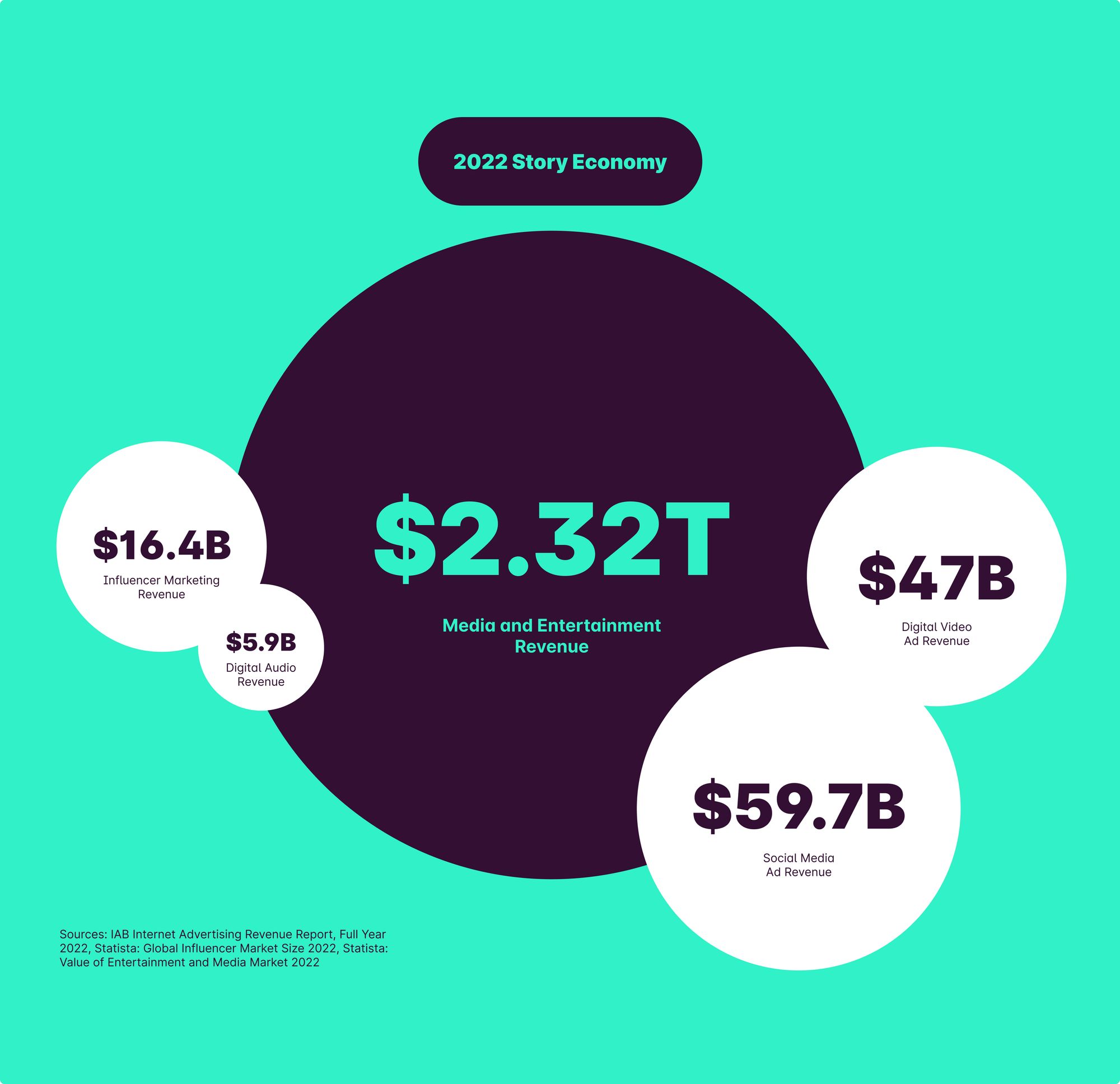Welcome to the Story Economy
The conventional wisdom suggests that we now live in a “creator economy.” As the Founder and CEO of a creator-first company, I’m here to…

The conventional wisdom suggests that we now live in a “creator economy.” As the Founder and CEO of a creator-first company, I’m here to tell you that’s just a tiny sliver of the truth. If we’re looking for a high-level framework to define this era, there’s a much more accurate way to describe it: We now live, work, play, and even sleep, in the “Story Economy.”
Here’s the abridged, recent timeline of the last 75 years of media in the United States: We went from a world of 3–4 networks in the 1950s to a world of print and TV ads in the 1980s to a world of Google/search advertising in the 2000’s to a world today dominated by social media platforms (Instagram, TikTok), user generated media platforms (Youtube, Patreon), and IP owning media and entertainment companies, who are either digital native or moving aggressively towards digital platforms. This bucket includes the subscription streaming services (Netflix, Hulu, Spotify) legacy media (Hearst, New York Times) and digital native, new media platforms (he Athletic, Calm).
We now live, work, play, and even sleep, in the ‘Story Economy.’
The common denominator of this new media landscape is that every one of the above entities trades in a commodity that did not even exist 20 years ago. Any guesses? It’s the digital story. Thanks to technology and the human need to tell stories, it is being produced, exchanged, and consumed at a speed and scale unlike anything seen in human history. The average internet user engages with more stories every day now than any other product or service — by a long shot. According to a new report by Hootsuite, in 2022, the average internet user between the ages of 16 and 64 will spend three hours a day watching video, nearly 2.5 hours on social media, two hours reading, and nearly two hours listening to audio and podcasts. That adds up to 9.5 hours interacting with stories every day.
Businesses are, in turn, spending more money on this commodity, which takes the form of editorial, branded content, entertainment, and digital ads. They are giving native digital consumers what they want.
What is the Story Economy All About?
The Story Economy is the aggregate of media and entertainment revenue, social media ad revenue, digital video ad revenue, influencer marketing revenue, and digital audio ad revenue.
In 2020, there was a sharp increase in digital media consumption, which had a direct correlation on digital video, audio, and social media ad revenues. This is largely due to the fact that so many people were at home and connected to their devices. This acceleration actually increased in 2021.
The dominant sector of the Story Economy is still media and entertainment, both legacy and digital, which is worth roughly $1 trillion in revenue.
Social media ad revenues as a category continued its upward trajectory, reaching $41.5 billion in 2020. In the second year of the pandemic, 2021, it grew by another 39%, reaching $57.7 billion, making up more than 30% of all internet ad revenue.
Digital video enjoyed 20.6% year-over-year growth, reaching $26.2 billion in 2020, according to a report by IAB. In 2021, digital video grew by 50.8%, reaching $39.5 billion.
When people talk about the “creator economy”, they’re referring to independent creators who make a living through influencer marketing or subscriptions. These creators represent $13 billion in revenue. While creators are attracting venture capital and attention of late, they represent just a small part of the broader Story economy.
2021 was a breakout year for digital audio revenues too. Buoyed by the popularity of podcasts, it had the highest growth rate of any media format, growing more than 57% from the prior year, reaching $4.9B.
This whole ecosystem I’ve outlined above, which includes both advertising and subscription based businesses is the “Story Economy.”

How Did We Get Here?
“An imagined reality is something that everyone believes in, and as long as this communal belief persists, the imagined reality exerts force in the world.”

This figurative imagery discovered in Indonesia is the original, most primitive version of Instagram. It is the earliest known human paintings from at least 40,000 years ago. These earliest stories were created by our hunters and gatherer ancestors for the purpose of survival. Instead of going up on the feed, it went up on a wall of a cave. They painted their food, their fears, and their gods. Like today’s social media, those who saw this first feed of visual imagery derived meaning, entertainment, and knowledge from the stories they depicted.
Well before the Old Testament was written, a unique, genetic mutation turned us into the first animal capable of telling stories. This evolutionary anomaly embedded in our DNA makes humans who we are. We are the only species we know that has evolved an ability to reconstruct the past using language and art, inspired by memory and emotion.
“These earliest stories were created by our hunters and gatherer ancestors for the purpose of survival. Instead of going up on the feed, it went up on a wall of a cave."
What’s changed is that humanity is no longer competing with lions to survive. We are now competing with ourselves. We are communicating what it means to be human. We are making sense of our purpose on this planet. We are changing our world. Stories are the primary vehicle for the evolution of mankind and by extension, our planet.
Enter the Super Commodity
In today’s world, storytelling as a discipline is at the heart of all innovation and entrepreneurship. It is the fundamental driver of success in business, media, journalism, film, photography, print, advertising, marketing, design, politics, and the creative arts.
Stories therefore touch every aspect of human life: commerce, politics, culture, the environment, and public health. They are the most powerful driver of religious, cultural and economic activity at scale. They are designed to affect the human mind and heart at the same time, leading people to click, purchase, or think in a certain way. As such, they can make or break individuals, companies, nations, and/or planets.
A skeptic might argue that this has always been the case, that stories have always been the dominant force shaping human behavior. And yes, that is completely true! What’s different now is that the production and distribution of stories has become democratized — and incentivized, which has led to unprecedented scale and reach. Unlike commodities like coffee, grain, or steel, stories are an infinite resource. And because they are now digital rather than physical, we are no longer limited by the geography of a specific cave wall that only gets seen by one family or clan: One person or organization’s social media wall can be seen by billions of people. Because of technological innovation and business models that have empowered humanity to create and distribute stories, this is the first commodity in human history that is essentially limitless. It is the first super commodity.
Unlike commodities like coffee, grain, or steel, stories are an infinite resource…It is the first super commodity.
The Achilles heel of a super commodity scaling to the quadrillions is that nobody has the attention or time to consume them. This is why Netflix and social media platforms like TikTok can sometimes feel so draining. We have not evolved to see so many potential stories. This is why you need to separate yourself, and help your audience find the signal amidst the noise.
How Can My Organization Compete in the Story Economy?
To survive and thrive in this new world businesses need to adapt now, or risk irrelevance. The first thing to immediately recognize is that regardless of what business you think you are in, you are actually in the story business. Period.
Your product or service matters too of course, but this is only half the battle.
If you are a human, business, organization, or nation-state, you are, for better or worse, going to be judged and known mainly by the stories you put out into the world.
“What’s required to succeed is a total transformation of your business into a storytelling-first operation.”
If you are a business leader, mastery of stories is key to mastery of your market, now and in the future. It doesn’t matter if you’re D2C, B2B, retail, e-commerce, not-for-profit, B-Corp, C-Corp, S-corp, or LLC, stories are the key to your business success. We’ve known in our bones that they have the ability to shape human behavior, but now there is an abundance of data proving that stories are powerful revenue drivers. (See “TikTok Made Me Buy It” as just one example. Stories motivate consumer behavior on both small and large scales, on a daily basis for millions of companies and organizations across the planet.
What is required to succeed in this era is not a passive investment in story, or media, production. What’s required to succeed is a total transformation of your business into a storytelling-first operation.
How To Transform
There are 5 key concepts to consider while transforming into a storytelling-first organization.
- Find your Authentic Voice: This is you telling the world why you exist. Your unique voice must come out. Telling your origin story and constantly reinforcing your purpose for existence is the best way to do it.
- Collaborate with Your Community: A community is a place where conversations are happening that are not happening anywhere else. Listen to those conversations and ask your community members to help share them with the world. Event videos and testimonial videos are impactful ways of doing this.
- Be Platform Specific: Each cave wall is different. Each platform is different. Each social media space is different. The audience is different. The language is different. The style is different. If you are trying to reach an audience on a specific platform, speak fluently and natively for that world.
- Create On Demand: You can’t wait for a news cycle. You can’t wait for your agency of record. In today’s world you can’t wait for anything. When world events happen, and they always do, you need to be “always on” in order to tell your story, in real time, authentically.
- Build Your Agile Workforce: The world’s greatest stories aren’t created through old-school mass advertising campaigns — they’re being told on the fly, with creator partnerships. But which creator partnership to use for which project? That is the question. A marketing team without an agile workforce is like a cub scout without a Swiss army knife. You need the right creator at the right time for the right project — or you’re going to be lost in the woods.
It’s important to note that this is not simply advice for a marketing team. This is a company-wide transformation. The CEO should help find the company’s voice. The customer success or community team should surface stories from the community. The marketing team should seek out creative partners and agile workforce platforms. The HR and operations teams should be ready re-structure the org chart and freelance hiring processes to suit the “always on” hiring needs of the company. A total transformation is required.
Where Are We Headed?
We’ve witnessed several major shifts in the past decade. We’ve seen streaming companies like Netflix take a big chunk out of Hollywood. We’ve seen social media networks grab huge market share from the traditional advertising channels. We’ve seen more and more consumers across the planet with the power to access any media anywhere in the world, in seconds, from a device that fits in their pockets.
The Story Economy is already massive from a revenue and user perspective. It may boggle your mind, but this is just the beginning. It will continue getting bigger because many of these digital production and distribution tools and platforms are so nascent. YouTube is only 17 years old. TikTok is six years old. For digital storytelling, this is like Hollywood in the 1950s. There is a ton of growth ahead.
It may boggle your mind, but the fact is that this is just the beginning.
Stories will also be an integral part of future technological disruption.
For those who believe that we are migrating from a centralized Web 2 to a decentralized Web 3, there’s a reason the most powerful first use cases for blockchain technology are in the form of non fungible tokens. The static and moving digital imagery, whose authenticity is encrypted and stored in the blockchain, is an amazing innovation. But at the end of the day, NFT’s are simply the latest version of a story, created with a shiny, new tool.
The truth is there’s never been a better time to be in the story business. And if you’re not yet comfortable telling your stories, it’s never too late.
For those who believe that we are migrating from a screen interface to an immersive Metaverse, there’s a reason some of the most powerful first use cases for the metaverse are in gaming experiences. These games are, you guessed it, also stories. If the world does move into this virtual landscape in the future, as long as humans are the ones living and buying there, we will see digital stories get replaced by “meta stories” as the dominant commodity of the metaverse.
The truth is there’s never been a better time to be in the story business. And if you’re not yet comfortable telling your stories, it’s never too late. Your organization is alive and breathing. Congratulations on that accomplishment. In order to thrive in the Story Economy, the time to transform is now.
By Jaron Gilinsky, Founder and CEO of Glimmer
